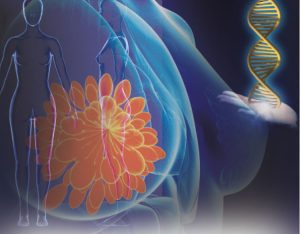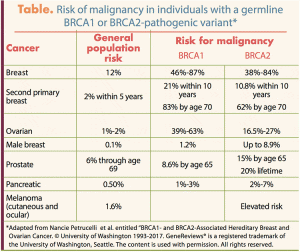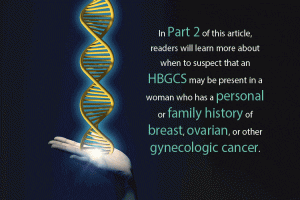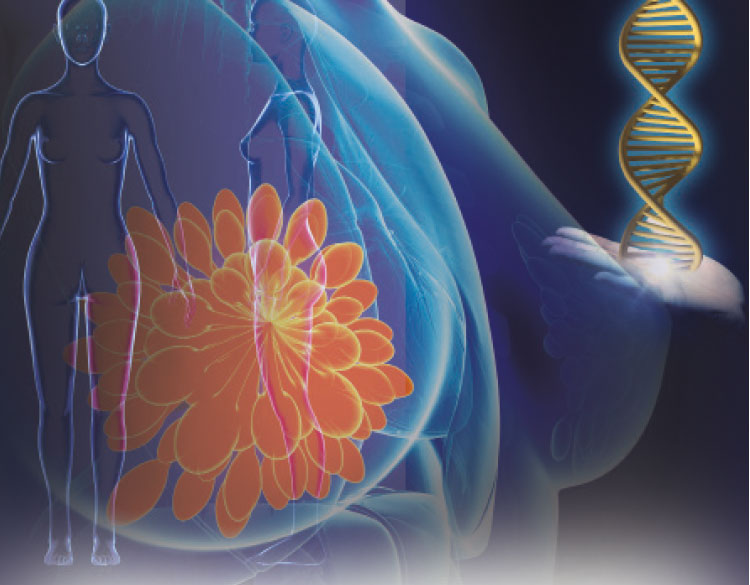 Faculty
Faculty
Kate McReynolds, APRN, MSc, MSN, ANP-BC, AGN-BC, is a Genetic Nurse Practitioner at Vanderbilt University Medical Center in Nashville, Tennessee.
Intended audience
This continuing education (CE) activity has been designed to meet the educational needs of nurse practitioners who provide care for women in any age bracket.
CE approval period
Now through September 30, 2018
Estimated time to complete this activity
1 hour
CE approval hours
1.0 contact hour of CE credit
This two-part article focuses on hereditary cancer syndromes associated with breast and gynecologic cancers. In part 1, the author provides background information about hereditary cancer, details several specific hereditary breast and gynecologic cancer syndromes (HBGCSs), and explains the gene alterations involved in these syndromes. In part 2, the author will describe ways that healthcare providers can identify women who may have one of these syndromes and who could therefore benefit from genetic risk assessment, counseling, and testing—processes she also discusses. The author will also explain how to interpret genetic test results and provide management recommendations for the two most common HBGCSs.
Educational objectives
At the conclusion of this educational activity, participants should be able to:
- Know the proportion of cancers that are hereditary, as compared with those that are sporadic or familial.
- Recognize genes that may have pathogenic variants that can cause an HBGCS.
- Understand the distinguishing characteristics of several different HBGCSs.
Accreditation statement
This activity has been evaluated and approved by the Continuing Education Approval Program of the National Association of Nurse Practitioners in Women’s Health (NPWH), and has been approved for 1.0 contact hour of CE credit.
Faculty disclosures
NPWH policy requires all faculty to disclose any affiliation or relationship with a commercial interest that may cause a potential, real, or apparent conflict of interest with the content of a CE program. NPWH does not imply that the affiliation or relationship will affect the content of the CE program. Disclosure provides participants with information that may be important to their evaluation of an activity. Faculty are also asked to identify any unlabeled/unapproved uses of drugs or devices made in their presentation.
Kate McReynolds, APRN, MSc, MSN, ANP-BC, AGN-BC, has no actual or potential conflicts of interest in relation to this presentation.
Disclosure of unlabeled use
NPWH policy requires authors to disclose to participants when they are presenting information about unlabeled use of a commercial product or device or an investigational use of a drug or device not yet approved for any use.
Disclaimer
Participating faculty members determine the editorial content of the CE activity; this content does not necessarily represent the views of NPWH. This content has undergone a blinded peer review process for validation of clinical content. Although every effort has been made to ensure that the information is accurate, clinicians are responsible for evaluating this information in relation to generally accepted standards in their own communities and integrating the information in this activity with that of established recommendations of other authorities, national guidelines, FDA-approved package inserts, and individual patient characteristics.
Successful completion of the activity
Successful completion of this activity, J-17-03, requires participants to:
- “Sign In” at the top right-hand corner of the page (npwh.org/courses/home/details/905) if you have an NPWH account. You must be signed in to receive credit for this course. If you do not remember your username or password, please follow the “Forgot Password” link and instructions on the sign-in page. If you do not have an account, please click on “Create an Account.”*
- Read the learning objectives, disclosures, and disclaimers on the next page.
- Study the material in the learning activity during the approval period (now through September 2018).
- Complete the post-test and evaluation. You must earn a score of 70% or better on the post-test to receive CE credit.
- Print out the CE certificate if successfully completed.
* If you are an NPWH member, were once a member, or have taken CE activities with NPWH in the past, you have a username and password in our system. Please do not create a new account. Creation of multiple accounts could result in loss of CE credits as well as other NPWH services. If you do not remember your username or password, please either click on the “Forgot username” or “Forgot password” link above or call the NPWH office at (202) 543-9693, ext. 1.
Commercial support
The content for this article was supported by an educational grant from Myriad Genetics Laboratories, Inc.
This two-part article focuses on hereditary cancer syndromes associated with breast and gynecologic cancers. In part 1, the author provides background information about hereditary cancer, details several specific hereditary breast and gynecologic cancer syndromes (HBGCSs), and explains the gene alterations involved in these syndromes. In part 2, the author will describe ways that healthcare providers can identify women who may have one of these syndromes and who could therefore benefit from genetic risk assessment, counseling, and testing—processes she also discusses. The author will explain how to interpret genetic test results and provide management recommendations for the two most common HBGCSs.
Key words: hereditary breast and gynecologic cancer syndrome, hereditary breast and ovarian cancer, HBOC, BRCA1, BRCA2, Lynch syndrome
Cancer can be categorized as sporadic, familial, or hereditary.1 Sporadic cancers (70%-80% of cancer cases) occur by chance—for example, because of a mistake that occurs during cell division—or as a result of a lifestyle choice (e.g., smoking) or a toxic environmental exposure. Familial cancers (15%-20% of cases) are likely caused by a combination of genetic and environmental risk factors.2 Although persons with familial cancers may have several relatives with the same type of cancer, a clear pattern of inheritance has not been established. Hereditary cancers (5%-10% of cases) occur when a person has a specific altered (mutated) gene in nearly every cell in the body.3 Persons with hereditary cancers are more likely to have family members with the same type or a related type of cancer. They tend to develop cancer at an earlier-than-average age and may develop more than one cancer in their lifetime.
The following statistics put the three categories of cancer in perspective. With regard to breast cancer, about 12% of women in the general population will develop the disease in their lifetime.4 A woman’s risk for developing breast cancer nearly doubles if she has a first-degree relative (mother, sister, daughter) with breast cancer.5 If genetic testing reveals that she has a BRCA1 mutation associated with hereditary breast and ovarian cancer (HBOC) syndrome, her risk for developing breast cancer may be as high as 72%.6 With regard to ovarian cancer, about 1.3% of women in the general population develop the disease.7 If a woman has a first-degree relative with ovarian cancer, her risk triples—to about 5%.8 If genetic testing reveals that she has a BRCA1 mutation, then her risk for developing ovarian cancer, according to data from the EMBRACE study, may be as high as 59%.9
Part 1 of this article provides general information about hereditary breast and gynecologic cancer syndromes (HBGCSs) and describes specific HBGCSs that healthcare providers (HCPs) caring for women may encounter in their practices. In addition, the author discusses how and why these syndromes develop. Part 2 of this article, which will appear in the next issue of Women’s Healthcare: A Clinical Journal for NPs, focuses on when to suspect that an HBGCS may be present in a woman with a personal or family history of breast, ovarian, or other gynecologic cancer; when it is appropriate to test for pathogenic variants (i.e., mutations) in genes that may be responsible for a breast or a gynecologic cancer; the implications that the findings, positive or negative, would have for a patient and her otherwise healthy female relatives; the types of genetic tests for the mutations associated with these syndromes that are available; and the implications of these test results—that is, how they should guide management.
Hereditary breast and gynecologic cancer syndromes
A hereditary cancer syndrome is a genetic predisposition to develop certain types of cancer that are caused by an inherited mutation (from either parent) in one or more genes and that may cause the early onset of these cancers.10 Many of these syndromes are caused by mutations in tumor suppressor genes that code for proteins that protect against cancer, although in some syndromes, the mutated genes may promote the growth of cancer cells. In most cases, these genetic mutations result in an increased cancer risk for multiple organs. This article reviews hereditary cancer syndromes that may lead to breast and/or gynecologic cancers, including HBOC syndrome, Lynch syndrome (LS), Li-Fraumeni syndrome (LFS), Peutz-Jeghers syndrome (PJS), and Cowden syndrome. A review of basic cancer genetics is available in the Box.
Box: Review of basic cancer genetics.
The nucleus is the structure in our cells that contains most of our genetic material (a small amount is found in the mitochondria). In humans, each nucleus has 23 pairs of chromosomes, which contain a total of about 20,000 genes. We have two copies of nearly all of our genes, one from each parent. Each gene consists of a long piece of DNA that provides instructions for protein synthesis. These proteins are used for cell structure, metabolism, and communication. As long as there is no mistake or mutation in the DNA, the protein will have the correct form and ability to be used by the body. However, a mutation existing in a gene may prevent the protein from being made, or the protein will not be correctly formed and will therefore not be utilized. Most of the aforementioned 20,000 genes make proteins that are not connected to cancer development. However, a number of genes, called tumor suppressor genes, code for proteins that are protective against cancer. For the purpose of this discussion, let us focus on a BRCA1 mutation associated with HBOC syndrome. BRCA1 is a tumor suppressor gene; the protein for which it codes protects against breast cancer, ovarian cancer, and pancreatic cancer in women. Women without BRCA1-associated HBOC syndrome have two normal copies of BRCA1 in nearly all their cells, including their breast tissue. A sporadic breast cancer occurs when, over the course of her life, a woman acquires a mutation in one copy of the BRCA1 gene in a breast cell from carcinogen exposure or from a mistake that occurred during cell division; this is the “first hit.” At this point, the second normal copy of the BRCA1 gene in this breast cell is still producing a protein that is protecting the cell from cancer. However, if the second copy of BRCA1 in this breast cell also acquires a mutation—the “second hit”—it may develop into a cancer because now both copies of the BRCA1 gene in the cell are incapable of producing the protective protein. It usually takes a long time for a cell to acquire the two hits; sporadic cancer is typically a disease diagnosed in older age. By contrast, a woman born with a BRCA1 mutation in one of her two copies of this gene has a head start in terms of her risk for developing breast cancer, ovarian cancer, or pancreatic cancer. Each breast cell in her body already contains the first hit. A BRCA1 mutation carrier needs only to acquire the second hit in a breast cell in order to develop cancer, an event that could occur at a relatively young age. Therefore, many women with an inherited BRCA1 mutation develop premenopausal breast cancer. A good point to remember is that all cancer is genetic—that is, of or related to aberrations in the genes—but not all cancer is hereditary.
[/su_box] Hereditary breast and ovarian cancer syndrome
Most cases of HBOC syndrome are caused by mutations in BRCA1 or BRCA2, which may be inherited from the mother or the father. Only one copy of the mutation is needed for a woman to be at increased risk for developing cancer of the breast and/or ovary (autosomal dominant inheritance).11 About 1 in 40 Ashkenazi (Eastern European) Jews is born with a BRCA1 or a BRCA2 mutation, as compared with 1 in 300-500 persons in the general U.S. population.12 Ashkenazi Jews’ increased likelihood of carrying a BRCA1 or a BRCA2 mutation is related to the founder effect, which is the reduced genetic diversity resulting when a population is descended from a small number of colonizing ancestors.
For women with a BRCA1 or a BRCA2 mutation, the risk for developing breast cancer starts to increase when they reach their mid-20s.9 With regard to ovarian cancer, the risk starts to increase for women with a BRCA1 mutation when they reach their mid-30s and for those with a BRCA2 mutation in their 40s to early 50s, although the risk is greatest when women with a BRCA1 or a BRCA2
mutation are in their 50s or older.6,9
Using the results of multiple studies, Petrucelli et al13 have summarized the risk for malignancy in individuals, both female and male, with a germline BRCA1/2 pathogenic variant (a germline mutation is one that can be transmitted to offspring) (Table). In terms of breast cancer in women, the risk is 46%-87% for those with a BRCA1 mutation and 38%-84% for those with a BRCA2 mutation. In terms of ovarian cancer, the risk is 39%-63% for women with a BRCA1 mutation and 16.5%-27% for those with a BRCA2 mutation.
In the general population, the risk for a second primary breast cancer is 2% within 5 years. By comparison, women with a BRCA1 mutation have a 21% risk within 10 years and an 83% risk by age 70, and those with a BRCA2 mutation have a 10.8% risk within 10 years and a 62% risk by age 70.13 Of note, however, for women with a BRCA1/2 mutation, the risk for developing a second breast cancer is highly dependent on the age at which breast cancer was first diagnosed. Women with a BRCA1/2 mutation who are diagnosed with breast cancer at age 30 have a very high risk of developing a second primary breast cancer, but the risk of developing a second primary breast cancer in a woman whose breast cancer is diagnosed later in life is significantly less than 83% for a BRCA1 mutation carrier and significantly less than 62% for a BRCA2 mutation carrier.9

Pancreatic cancer risk is 0.5% in the general population, as compared with 1%-3% in women with a BRCA1 mutation and 2%-7% in those with a BRCA2 mutation.13 Women with a BRCA2 mutation may also be at increased risk for melanoma.14 Finally, a recent study showed that women with a BRCA1 mutation who had undergone a risk-reducing salpingo-oophorectomy (RRSO) without hysterectomy had a slightly higher risk of developing serous and/or serous-like endometrial carcinomas, but not endometroid endometrial carcinomas or sarcomas.15
Most BRCA1- and BRCA2-related breast cancers are invasive ductal carcinomas, which are more likely to be of higher histologic grade than sporadic breast cancers. Triple-negative breast cancers are more common in BRCA1 mutation carriers than in women with sporadic breast cancer. By contrast, BRCA2-related breast cancers tend to be hormone receptor positive.16 Ovarian cancers related to BRCA1/2 mutations are usually serous adenocarcinomas. Compared with ovarian cancers in non-carriers, those in BRCA1/2 mutation carriers are also more likely to be high grade.17
LS is an autosomal dominant hereditary cancer syndrome caused by a mutation in a mismatch repair gene: MLH1, MSH2, MSH6, PMS2, or EPCAM.18 LS—also known as hereditary nonpolyposis colorectal cancer syndrome, or HNPCC—confers a high risk for colorectal cancer (CRC) and has a population prevalence of 1 in 600-3,000.18-20 Individuals with LS may have up to an 82% lifetime risk of developing CRC, although some data indicate that the risk is lower in women than in men.21 Of note, these cancer risks vary significantly, depending on which gene mutation is involved. For example, CRC risk associated with a mutation in MLH1 or MSH2 is 52%-82%, whereas that associated with a mutation in MHS6 is 10%-22%.22
In addition to CRC, LS predisposes women to the development of certain gynecologic cancers. For women with an MLH1 or an MSH2 mutation, lifetime risk for endometrial cancer is 25%-60% and that for ovarian cancer is 4%-24%. Risks for gynecologic cancers in MSH6 and PMS2 mutation carriers are increased but to a lesser degree.22 LS accounts for most cases of hereditary uterine cancer and CRC, and is the second most common cause of inherited ovarian cancer (after HBOC).23 Other cancers associated with LS include urothelial cancer, central nervous system cancer, gastric cancer, small bowel cancer, sebaceous carcinoma, hepatobiliary tract cancer, and pancreatic cancer.18

Li-Fraumeni syndrome
The population prevalence of this highly penetrant autosomal dominant syndrome is 1 in 5,000-20,000.24 Women who carry a germline mutation in the TP53 gene associated with LFS have a lifetime risk for cancer of nearly 100%, including a breast cancer risk of up to 60%, which often occurs when they are in their 20s or 30s.25,26 Other core cancers associated with LFS are sarcomas (soft-tissue and bone), brain cancers, and adrenocortical carcinomas, although a variety of other cancers may occur.26 Gynecologic cancers associated with LFS include ovarian cancer and endometrial cancer. Women with LFS also have a significantly increased risk of developing multiple primary cancers.27
Peutz-Jehgers syndrome
Estimates for the birth prevalence of this rare syndrome range widely, from 1 in 25,000 to 1 in 280,000.28 This autosomal dominant syndrome is caused by mutations in the
STK11 gene and is characterized by hamartomatous polyps in the gastrointestinal (GI) tract, mucocutaneous pigmentation, and increased risk
for cancer. PJS is associated with elevated lifetime risks for breast cancer (32%-54%), benign ovarian tumors (sex cord tumors with annular tubules; 21%), rare and aggressive adenoma malignum of the cervix (10%), and uterine cancer (9%). Persons with PJS are also at increased risk for cancers of the pancreas and lung.
Cowden syndrome
This autosomal dominant syndrome is caused by mutations in the PTEN gene.29 This syndrome has a population prevalence of 1 in 200,000.24 Pathognomonic skin lesions such as papillomatous papules on the face and mucous membranes are nearly always present by age 30, and hamartomatous and mixed GI polyps, which increase the risk for CRC, are seen frequently. Cowden syndrome carries high lifetime risks for breast cancer (up to 85%) and endometrial cancer (up to 28%)29 in addition to increased risks for colon cancer, thyroid cancer, renal cell carcinoma, and melanoma.
Clinical implications
Identifying individuals who may have a hereditary cancer syndrome is an important task for nurse practitioners.30 If a woman is found to have an HBGCS, then risk reduction and/or screening measures can be implemented to prevent cancer or find it at an early stage. In addition, relatives of patients with an HBGCS can be offered individualized and quantified assessment of their own cancer risk, as well as options for tailored screening and prevention strategies.31 In Part 2 of this article, readers will learn more about when to suspect that an HBGCS may be present in a woman who has a personal or family history of breast, ovarian, or other gynecologic cancer. They will also find out more about the genetic risk assessment, counseling, and testing processes; the interpretation of genetic test results; and management recommendations for HBOC and LS, the two most common HBGCSs. =
References
- American Cancer Society. Family Cancer Syndromes. 2017. cancer.org/cancer/cancer-causes/genetics/
family-cancer-syndromes.html - National Institutes of Health. National Center for Advancing Translational Sciences. Genetic and Rare Diseases Information Center. Familial Breast Cancer.
- American Society of Clinical Oncology. Understanding Hereditary Cancer Syndromes. 2017.
- National Cancer Institute. Surveillance, Epidemiology, and End Results Program. Cancer Stat Facts: Female Breast Cancer. 2012.
- American Cancer Society. Breast Cancer Risk Factors You Cannot Change. 2017.
- Kuchenbaecker KB, Hopper JL, Barnes DR, et al. Risks of breast, ovarian, and contralateral breast cancer for BRCA1 and BRCA2 mutation carriers. JAMA. 2017;317(23):2402-2416.
- National Cancer Institute. Surveillance, Epidemiology, and End Results (SEER) Program. Cancer Stat Facts: Ovarian Cancer. 2017.
- Soegaard M, Frederiksen K, Jensen A, et al. Risk of ovarian cancer in women with first-degree relatives with cancer. Acta Obstet Gynecol Scand. 2009;88(4):449-456.
- Mavaddat N, Peock S, Frost D, et al. Cancer risks for BRCA1 and BRCA2 mutation carriers: results from prospective analysis of EMBRACE. J Natl Cancer Inst. 2013;105(11):812-822.
- ACOG Committee on Genetics. Committee Opinion Number 634: Hereditary Cancer Syndromes and Risk Assessment. June 2015.
- Cancer.net. Hereditary Breast and Ovarian Cancer. 2017.
- CDC. Hereditary Breast and Ovarian Cancer (HBOC) Syndrome. Page last updated September 14, 2015.
- Petrucelli N, Daly MB, Pal T. BRCA1- and BRCA2-associated hereditary breast and ovarian cancer. GeneReviews® [Internet]. Last updated December 15, 2016.
- Moran A, O’Hara C, Khan S, et al. Risk of cancer other than breast or ovarian in individuals with BRCA1 and BRCA2 mutations. Fam Cancer. 2012;11(2):235-242.
- Shu CA, Pike MC, Jotwani AR, et al. Uterine cancer after risk-reducing salpingo-oophorectomy without hysterectomy in women with BRCA mutations. JAMA Oncol. 2016;2(11):1434-1440.
- van der Groep P, van der Wall E, van Diest PJ. Pathology of hereditary breast cancer. Cell Oncol (Dordr). 2011;34(2):71-88.
- Liu G, Yang D, Sun Y, et al. Differing clinical impact of BRCA1 and BRCA2 mutations in serous ovarian cancer. Pharmacogenomics. 2012;13(13):1523-1535.
- Kohlmann W, Gruber SB. Lynch syndrome. GeneReviews® [Internet]. Last updated May 22, 2014.
- Dunlop MG, Farrington SM, Nicholl I, et al. Population carrier frequency of hMSH2 and hMLH1 mutations. Br J Cancer. 2000;83(12):1643-1645.
- de la Chapelle A. The incidence of Lynch syndrome. Fam Cancer. 2005;4(3):233-237.
- Barrow E, Hill J, Evans DG. Cancer risk in Lynch syndrome. Fam Cancer. 2013;12(2):229-240.
- National Comprehensive Cancer Network. Genetic/familial high-risk assessment: colorectal. Version 2.2016. 2016.
- Meyer LA, Broaddus RR, Lu KH. Endometrial cancer and Lynch syndrome: clinical and pathologic considerations. Cancer Control. 2009;16(1):14-22.
- National Comprehensive Cancer Network. NCCN Clinical Practice Guidelines in Oncology: Genetic/Familial High-Risk Assessment: Breast and Ovarian. Version 2.2017. 2016.
- Gonzalez KD, Noltner KA, Buzin CH, et al. Beyond Li Fraumeni Syndrome: clinical characteristics of families with p53 germline mutations. J Clin Oncol. 2009;27(8):1250-1256.
- Schneider K, Zelley K, Nichols KE, Garber J. Li-Fraumeni syndrome. GeneReviews® [Internet]. Last updated April 11, 2013.
- Mai PL, Best AF, Peters JA, et al. Risks of first and subsequent cancers among TP53 mutation carriers in the National Cancer Institute Li-Fraumeni syndrome cohort. Cancer. 2016;122(23):3673-3681.
- Tchekmedyian A, Amos CI, Bale SJ, et al. Findings from the Peutz-Jehgers syndrome registry of Uruguay. PLoS One. 2013;8(11):e79639.
- Eng C. PTEN Hamartoma Tumor Syndrome. GeneReviews® [Internet]. Last updated June 2, 2016.
- McReynolds K, Lewis S. Genetic counseling for hereditary cancer: a primer for NPs. Nurse Pract. 2017;42(7):22-28.
- Lancaster JM, Powell CB, Chen LM, Richardson DL; SGO Practice Committee. Society of Gynecologic Oncology statement on risk assessment for inherited gynecologic cancer predispositions. Gynecol Oncol. 2015;136(1):3-7.
Web resource: npwh.org/courses/home/details/905

